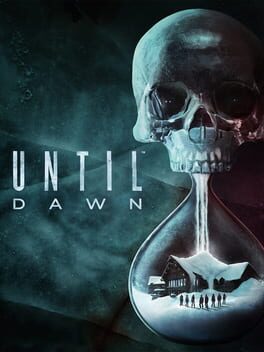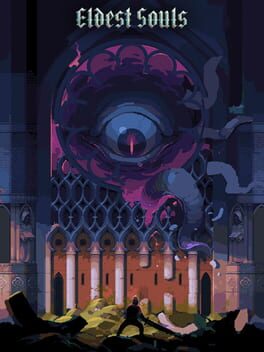JimBuss
Bio
Just a guy with a dream.
Just a guy with a dream.
Badges

N00b
Played 100+ games

1 Years of Service
Being part of the Backloggd community for 1 year

Liked
Gained 10+ total review likes

Busy Day
Journaled 5+ games in a single day
116
Total Games Played
000
Played in 2024
000
Games Backloggd
Recently Played See More
Recently Reviewed See More
The best game supermassive made. After a disappointing experience with last year’s "The Devil in Me" and mixed feelings about other entries in the Dark Pictures Anthology, I approached "Until Dawn" with a mix of eagerness and caution. This game, developed by Supermassive Games, marks the studio's initial foray into the narrative-driven horror genre that would spawn the anthology series I've come to associate with my yearly spooky season ritual.
Despite my reservations, stemming from recent letdowns in the series, "Until Dawn" proved to be a compelling rediscovery of what initially cemented Supermassive Games as a notable developer in interactive horror.
Narrative and Character Depth:
"Until Dawn" features a group of teenagers who reconvene at a remote mountain cabin on the anniversary of a tragedy that befell their friends. Unlike the cardboard cutouts that plagued my playthrough of "The Devil in Me," the characters in "Until Dawn" are surprisingly multi-dimensional. Characters like Mike and Emily, who initially come off as stereotypical horror archetypes—the jerk and the bossy girl—gradually reveal deeper, more relatable facets of their personalities. Mike shows genuine care amidst the chaos, and Emily’s tough exterior cracks to unveil insecurities that enrich her character beyond initial impressions.
Gameplay and Mechanics:
The game operates on the “butterfly effect” mechanic, where every decision impacts the story’s progression and outcomes. This not only adds weight to each choice but also significantly boosts the game's replayability. Players find themselves pondering the ramifications of each decision, knowing that even seemingly minor actions can have far-reaching consequences for the characters’ fates.
Visuals and Performance:
"Until Dawn" excels in areas where its successors have faltered. The facial animations and voice acting are top-notch, contributing to a richly immersive experience. Emotional nuances are captured with a precision that I found lacking in later titles like "The Devil in Me." This attention to detail in visual storytelling amplifies the tension and emotional gravity of the narrative, pulling you deeper into the chilling atmosphere of the game.
Plot Intricacies:
While certain plot elements can feel predictable—such as the twists involving a tattoo and an ill-conceived prank—the story remains engaging. These moments, although easy to guess for seasoned horror aficionados, are crafted well enough to maintain suspense and intrigue. The narrative cleverly weaves together classic horror tropes with fresh twists, keeping players on edge and invested in the characters’ survival.
Conclusion:
"Until Dawn" stands out not only as a pioneer for Supermassive Games but as a benchmark in interactive horror storytelling. Its ability to blend character depth with gripping narrative choices sets a high standard that subsequent titles in the genre struggle to meet. The game captures the essence of a horror movie marathon, complete with all the thrills, scares, and last-minute saves you'd expect.
Despite a few predictable plot points, "Until Dawn" is a masterclass in how to craft a compelling, choice-driven horror game. It serves as a stark reminder of the potential within the genre when executed with care and creativity. For those looking to fill the void left by this year's delayed Dark Pictures installment, "Until Dawn" offers a thrilling, chilling adventure that’s sure to satisfy your horror cravings.
Despite my reservations, stemming from recent letdowns in the series, "Until Dawn" proved to be a compelling rediscovery of what initially cemented Supermassive Games as a notable developer in interactive horror.
Narrative and Character Depth:
"Until Dawn" features a group of teenagers who reconvene at a remote mountain cabin on the anniversary of a tragedy that befell their friends. Unlike the cardboard cutouts that plagued my playthrough of "The Devil in Me," the characters in "Until Dawn" are surprisingly multi-dimensional. Characters like Mike and Emily, who initially come off as stereotypical horror archetypes—the jerk and the bossy girl—gradually reveal deeper, more relatable facets of their personalities. Mike shows genuine care amidst the chaos, and Emily’s tough exterior cracks to unveil insecurities that enrich her character beyond initial impressions.
Gameplay and Mechanics:
The game operates on the “butterfly effect” mechanic, where every decision impacts the story’s progression and outcomes. This not only adds weight to each choice but also significantly boosts the game's replayability. Players find themselves pondering the ramifications of each decision, knowing that even seemingly minor actions can have far-reaching consequences for the characters’ fates.
Visuals and Performance:
"Until Dawn" excels in areas where its successors have faltered. The facial animations and voice acting are top-notch, contributing to a richly immersive experience. Emotional nuances are captured with a precision that I found lacking in later titles like "The Devil in Me." This attention to detail in visual storytelling amplifies the tension and emotional gravity of the narrative, pulling you deeper into the chilling atmosphere of the game.
Plot Intricacies:
While certain plot elements can feel predictable—such as the twists involving a tattoo and an ill-conceived prank—the story remains engaging. These moments, although easy to guess for seasoned horror aficionados, are crafted well enough to maintain suspense and intrigue. The narrative cleverly weaves together classic horror tropes with fresh twists, keeping players on edge and invested in the characters’ survival.
Conclusion:
"Until Dawn" stands out not only as a pioneer for Supermassive Games but as a benchmark in interactive horror storytelling. Its ability to blend character depth with gripping narrative choices sets a high standard that subsequent titles in the genre struggle to meet. The game captures the essence of a horror movie marathon, complete with all the thrills, scares, and last-minute saves you'd expect.
Despite a few predictable plot points, "Until Dawn" is a masterclass in how to craft a compelling, choice-driven horror game. It serves as a stark reminder of the potential within the genre when executed with care and creativity. For those looking to fill the void left by this year's delayed Dark Pictures installment, "Until Dawn" offers a thrilling, chilling adventure that’s sure to satisfy your horror cravings.
After delving into "Eldest Souls" for a significant stretch, I find myself reflecting on the growing appeal of indie games compared to mainstream offerings. Recently, indie titles like "Eldest Souls" have sparked more enthusiasm in me than many big-budget games. This game, with its intriguing blend of 'soulslike' mechanics and crisp narrative delivery, offers a refreshing take on the genre.
"Eldest Souls" begins with a setting typical of soulslike games—a lone warrior traversing a historically rich, battle-scarred landscape. The narrative unfolds through environmental clues and item descriptions, painting a picture of ancient gods and crusader-like knights that once shaped the land. This setup is intriguing and invites players to dive deeper into the game's lore.
The gameplay in "Eldest Souls" focuses on intense, boss-rush challenges that incorporate innovative mechanics well-suited to the top-down perspective. Each boss battle is a testament to the game’s core appeal, blending recognizable 'souls' motifs with unique elements that elevate the combat experience. The use of the environment, dynamic music shifts, and phase changes in bosses make each encounter a thrilling, strategic battle. It's clear the developers have poured their passion into these engagements, crafting moments that challenge and reward in equal measure.
Graphically, the game is stunning, with beautifully rendered art and an atmospheric soundtrack that enhances the somber, immersive feel of the game. The art style pays homage to the dark fantasy genre while infusing it with originality, making every area and encounter memorable.
Gameplay customization allows for varied combat styles, from agile dodging to robust, defensive play. This flexibility encourages experimentation and adaptability, enriching the combat dynamics and replayability of the game. Each style brings something different to the battles, influencing not just how you fight but also how you navigate the game's world and interact with its characters.
Despite its strengths, "Eldest Souls" does have its drawbacks. The most notable is its length; the game feels too short, leaving a sense of wanting more just as you settle into its rhythm. While its brevity ensures that the gameplay doesn't become tedious, it also means that the experience ends all too quickly. This is somewhat mitigated by the game’s high replayability and the changes introduced in New Game+, which adjusts boss mechanics to provide fresh challenges.
The developers, a small team from Italy, deserve commendation for their work. It’s heartening to see such creativity and dedication thrive, especially given the challenging creative environment in Italy. Their success with "Eldest Souls" is a beacon of hope for aspiring game developers in similar situations.
In conclusion, "Eldest Souls" is a finely crafted gem that stands out in the sea of soulslike games. Its compelling boss fights and artistic execution make it a must-play for fans of the genre. While the game may be brief, its intensity and the mastery with which it's crafted make every moment count. It’s a testament to the potential lurking in the indie game development scene, proving that with passion and creativity, small teams can deliver experiences that resonate deeply with players.
"Eldest Souls" begins with a setting typical of soulslike games—a lone warrior traversing a historically rich, battle-scarred landscape. The narrative unfolds through environmental clues and item descriptions, painting a picture of ancient gods and crusader-like knights that once shaped the land. This setup is intriguing and invites players to dive deeper into the game's lore.
The gameplay in "Eldest Souls" focuses on intense, boss-rush challenges that incorporate innovative mechanics well-suited to the top-down perspective. Each boss battle is a testament to the game’s core appeal, blending recognizable 'souls' motifs with unique elements that elevate the combat experience. The use of the environment, dynamic music shifts, and phase changes in bosses make each encounter a thrilling, strategic battle. It's clear the developers have poured their passion into these engagements, crafting moments that challenge and reward in equal measure.
Graphically, the game is stunning, with beautifully rendered art and an atmospheric soundtrack that enhances the somber, immersive feel of the game. The art style pays homage to the dark fantasy genre while infusing it with originality, making every area and encounter memorable.
Gameplay customization allows for varied combat styles, from agile dodging to robust, defensive play. This flexibility encourages experimentation and adaptability, enriching the combat dynamics and replayability of the game. Each style brings something different to the battles, influencing not just how you fight but also how you navigate the game's world and interact with its characters.
Despite its strengths, "Eldest Souls" does have its drawbacks. The most notable is its length; the game feels too short, leaving a sense of wanting more just as you settle into its rhythm. While its brevity ensures that the gameplay doesn't become tedious, it also means that the experience ends all too quickly. This is somewhat mitigated by the game’s high replayability and the changes introduced in New Game+, which adjusts boss mechanics to provide fresh challenges.
The developers, a small team from Italy, deserve commendation for their work. It’s heartening to see such creativity and dedication thrive, especially given the challenging creative environment in Italy. Their success with "Eldest Souls" is a beacon of hope for aspiring game developers in similar situations.
In conclusion, "Eldest Souls" is a finely crafted gem that stands out in the sea of soulslike games. Its compelling boss fights and artistic execution make it a must-play for fans of the genre. While the game may be brief, its intensity and the mastery with which it's crafted make every moment count. It’s a testament to the potential lurking in the indie game development scene, proving that with passion and creativity, small teams can deliver experiences that resonate deeply with players.







